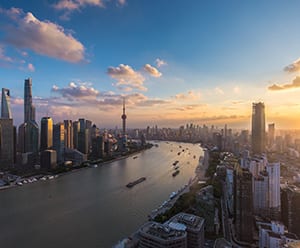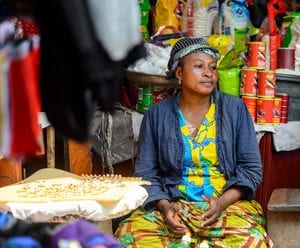
6 logistics corridors that are paving the way for intra-Africa trade

From a two-story specialty coffee house in Nigeria’s capital city Abuja, a barista uses a mobile app to order fresh coffee beans from a plantation nestled over 500 kilometers away on the outskirts of the scenic Mambilla Plateau.
She tracks her order in real time using a GPS function and receives her package within days. Some years back, such a delivery would have taken at least two weeks to complete.
Achieving this in a matter of days is a clear by-product of the country’s burgeoning e-commerce scene, which is expected to hit US$75 billion (€67.15 billion) by 2025.
And Nigeria’s e-commerce awakening is a phenomenon observed across the region.
With a fast-growing youth population, expanding middle-class and the second-largest Internet user population in the world, Africa is fast on its way to becoming a global powerhouse in online retail.
The rise of multimodal corridors in recent years, in particular, has played a significant role in transforming supply chains within the continent, which have long been held back by poor infrastructure and an outdated logistics framework.
They also help to link coastal countries to the hinterlands, allowing African countries to reap the benefits of the landmark African Continental Free Trade Agreement.
Here are six logistics corridors that are putting Africa on the global trade map.
1. Tangier-Agadir Corridor
Sitting in the northern part of Africa, the Tangier-Agadir Corridor comprises the Tanger Med Port and Free Zone, the 350 km Tangier-Casablanca rail, and an 800 km expressway.
With an unparalleled port capacity of almost 4.8 million Twenty-foot Equivalent Units (TEUs) in 2019, the Tanger Med port along the Strait of Gibraltar has allowed Morocco to capitalize on the growing transshipment market in the region — making it the biggest port in Africa.
By 2028, it will become the largest container port in the Mediterranean, thanks to expansion plans to raise the port’s annual capacity to 9 million TEUs.
The Tanger Free Zone (TFZ)’s four export-oriented free trade zones have also attracted hundreds of foreign companies from the automotive, aeronautics and textile sectors hoping to target the European market.
This has transformed the local automobile sector, which in 2017 became Morocco’s top export sector.
The vast potential of the corridor has caught the attention of third-party logistics players like DHL Global Forwarding, which set up a logistics hub in Tanger Med port last year.
The 6,000 square-meter facility is the company’s largest facility in Morocco, serving as a gateway to international markets like Europe, North and West Africa. On top of air, sea and road freight services, the facility also specializes in customs clearance facilitation and supply chain management.
Another key feature of the TFZ is the Tangier-Casablanca rail which connects five free-trade zones to the port, bringing together over 800 businesses while creating revenues of almost US$7.1 billion.
2. Djibouti-Addis Ababa Corridor
The Djibouti-Addis Ababa Corridor on the eastern tip of Africa is home to the continent’s most technologically advanced container terminal.
It also includes the 4,800-hectare Djibouti International Free Trade Zone (DIFTZ), the largest free trade zone in Africa, which will be opening in phases leading up to 2028.
Strategically located at the mouth of the Bab el Mandeb Strait, the biggest shipping lane between Asia and Europe, the Doraleh Port is the jewel crown of Ethiopia’s sea trade. About 95 percent of its imports come through the zone.
Djibouti’s location at the entrance of the Red Sea means it is exceptionally well-placed along major trading routes. About 10 percent of oil exports and 20 percent of commercial goods pass through the narrow strait right off Djibouti’s coast on their way to and from the Suez Canal.
Another important feature of the corridor is the Djibouti-Ethiopia railway which connects businesses to industrial hubs across Ethiopia. The 728 km line has cut journey times between the destinations from four days to 12 hours.
3. Abidjan-Lagos Corridor
Spanning the southern Atlantic shores of the Ivory Coast, the Abidjan-Lagos Corridor stretches across more than 1,000 km of roads.
Work on the Abidjan-Lagos Corridor Highway is underway — a six-lane motorway that will connect five of Africa’s largest and most economically vibrant cities: Abidjan, Accra, Cotonou, Lomé, and Lagos.
Jointly funded by The ECOWAS Commission, the African Development Bank and the European Union, the highway will allow landlocked countries like Burkina Faso, Mali and Niger to gain access to thriving seaports in West Africa.
The project is expected to spur economic development in the area with the development of economic zones like logistics centers and industrial zones, along with cross-border and regional markets.
It is estimated that the development will bring together more than 30 million urban dwellers and drive almost 75 percent of the region’s economic activity.
4. Mombasa-Kigali Corridor
Over on the south-eastern coast of Africa, the Mombasa-Kigali Corridor comprises the Mombasa Port, the Mombasa-Nairobi railway network, and over 1,700 km of roads that link both cities.
As Africa’s fifth-busiest port, the 1.1 million TEU Mombasa Port is the main trade gateway for the Eastern Africa region connecting Kenya with seven neighbors that include Uganda, Somalia, Rwanda and South Sudan.
Its strategic location has helped to boost local businesses, and annual cargo traffic is expected to rise further from 32 million tons in 2018 to 47 million tons by 2025.
Another key element of the corridor is the US$3.8 billion Mombasa-Nairobi railway that connects Kenya to Uganda.
Running 470 km across nine port terminal stations, the rail allows containers to be loaded directly onto trains for transportation to Nairobi. It operates 14 freight trains per day carrying almost 750 TEUs of containers, while reducing travel time for freight from 12 days to only eight hours.
5. Durban-Lubumbashi Corridor
The region’s busiest corridor in terms of both values and freight, the Durban-Lubumbashi Corridor — also known as the North-South Corridor — is a combination of two traditional corridors connecting the port of Durban in Southern Africa to the Eastern Port of Dar es Salaam.
Durban Port stands out as one of the world’s leading container ports linked by rail and road to over seven African countries.
As the best-performing Sub-Saharan Africa port, Durban Port serves as the main gateway to the Gauteng province, one of South Africa’s leading economic hubs situated some 600 km from the port.
It is also the country’s main port for the automotive sector, overseeing 66 percent of vehicle manufacturers’ imports and exports.
In 2018, the port handled almost 2.7 million TEUs of containers, 10.7 million tons of dry bulk, 28 million tons of liquid bulk cargo, 455,000 units of automotive parts and 2.2 million tons of breakbulk cargo.
6. Moatize-Nacala Corridor
The Moatize-Nacala corridor is one of Mozambique’s main economic drivers, comprising a world-class deep sea port and a state-of-the-art railway network.
Started in 2012 by Brazilian mining conglomerate Vale and Mozambique’s state port and railway operator CFM, with support from Mitsui of Japan, the 912 km project connects northern Mozambique, southern Malawi and the Moatize coalfield.
The goal is to enable some 18 metric tons per annum of coal to be exported to key markets like Asia, Europe, India and the Americas.
When in full operation, the rail segment of the Nacala Logistics Corridor is expected to raise coal exports by a whopping 40 percent.
Apart from being the deepest port in Southern Africa, the Port of Nacala in northern Mozambique is also a key terminal for coal for the Moatize mine in the province of Tete.
As promising as the future of Africa’s logistics framework looks, the glue that will hold it all together is ultimately the cooperation of governments, leaders and third-party logistics partners, explained Amadou Diallo, CEO, DHL Global Forwarding Middle East and Africa.
“Just as Asia and Europe have done, Africa urgently needs to simplify operations and eliminate borders to accelerate intra-African trade and unleash an economic boom,” he said.
“This has to start and end with a complete policy engagement at the regional and sub-regional level. Working together as one will open up avenues for long-term growth, ultimately putting Africa on the world map for free and open trade.”
ALSO WORTH READING
















 English
English